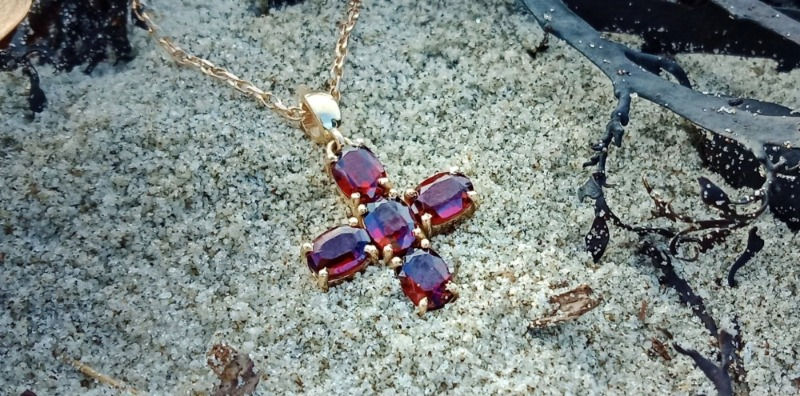Turquoise - sky blue to sea green
- Chris & Lee Minturn

- Mar 31, 2023
- 3 min read
Updated: May 17
Turquoise is one of the oldest protection gemstones known to man. Its colour ranges from sky blue to sea green, and everything in-between.
Turquoise has remained important since ancient civilisations. Valued not only for its beauty, but for its supernatural properties channelled by Healers. It is a symbol of wealth, friendship, and wisdom.
Turquoise was exploited from mines that were close to the Trade routes in Sinai & Iran, with this beautiful gemstones being traded throughout the Europe, and the Middle and Far East regions throughout millennia.
Persian Turquoise (Pirouzeh) is the purest of sky blues. The Northern mines in Persia (Iran) are in arid volcanic land, ideal conditions for long term chemical reactions by acidic groundwater to seep into Copper and Aluminium Phosphatic rock. The amount of Copper in the hydrated Phosphate mineral determines the brilliant blue we have come to admire. This is also know as Robin's egg blue. This beautiful sky blue material is vein free.
Sinai Turquoise (Mefkat) deposits were exploited by the ancient Egyptians to adorn and enrich their design of royal jewellery, amulets, divine offerings, carved objects like scarab, tomb decorations, architectural detail, elaborate ceremonial/burial masks to name a few. These mines in South Sinai are still producing Turquoise for sale by local Traders but, the origin of their raw material is closely guarded by them.

Navajo Turquoise was used as beautiful organic ceremonial adornment, amulets & for use in the home carved animals (these are called "fetishes" when blessed by a Medicine Man and cared for as prescribed. turquoise was used to bring good fortune, protection and to save-guard health. After the Spanish invasion, the Navajo people adopted silversmithing methods and developed their own unique voice in depiction of tribal and spiritual designs in their contemporary jewellery and Objet d'Art. From the 1960's many Native Indian Artisans have celebrated their heritage in their art form with many pieces being coveted and warmly adopted by tourists for the past 50+ years. Many of us have intricate and/or large jewels handcrafted by these talented Artisans, as cherished mementos of your journeys.

As with any gemstone the commercial market has developed synthetic and imitation Turquoise that jettisoned the use of Turquoise into fashion, non-more so than in jewellery designs in the 1960-70's.
Although imitation Turquoise made of glass or dyed clay can be found in Egyptian and later in the Roman times, the gemstone can be confused with more modern alternatives like Amazonite, dyed Howlite, porcelain, and plastic.

Properties of sky blue to sea green Turquoise
Veins or veinlets are also knowns as spiderwebs and matrix.
The colour of the matrix denotes the presence of black Manganese and brown Limonite.
The amount Copper in the mined material determines the intensity of blue; Iron is present in the raw material from the Southwestern, instead of Aluminium. This Iron content determines the green hues of the gemstone.
Gemstone quality Turquoise is often waxed to highlight the colour of the polished material. Waxing increases durability and resistance from oils and liquids.
Turquoise changes in hue over many years of wear.
Stabilised & reconstituted Turquoise is the most common on the market today.
Turquoise is soft, appearing on the Moh's Scale of hardness at 5 - 6.
It is sensitive to friction generated heat.
It is sensitive to intense light and overly dry conditions.
Unfortunately, many pieces of Turquoise are not of gemstone quality, today.
Deposits are mined, with low and commercial yields, from Northern Iran, Afghanistan, South Sinai, Israel, Southwestern regions USA, (the Sleeping Beauty mine closed in 2012), Mexico, Argentina, Brazil, Tibet, China, and Australia.
References
Ring 11th-12th Century. Open Access at The Met. Retrieved 31/03/2023.
https://images.metmuseum.org/CRDImages/is/original/sf1981-232-1a.jpg
Schmuckmuseum Pforzheim. "Die Sammlung Patti C. Birch im Schmuckmuseum Pforzheim." In Schmuck aus Persien. Pforzheim: Schmuckmuseum Pforzheim, 1974. no. 94, ill, pl. 94 (b/w).
Jenkins-Madina, Marilyn, and Manuel Keene. Islamic Jewelry in the Metropolitan Museum of Art. New York, 1983. no. 34a, p. 65, ill. (b/w).








Comments